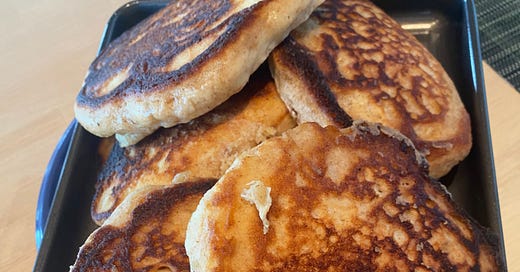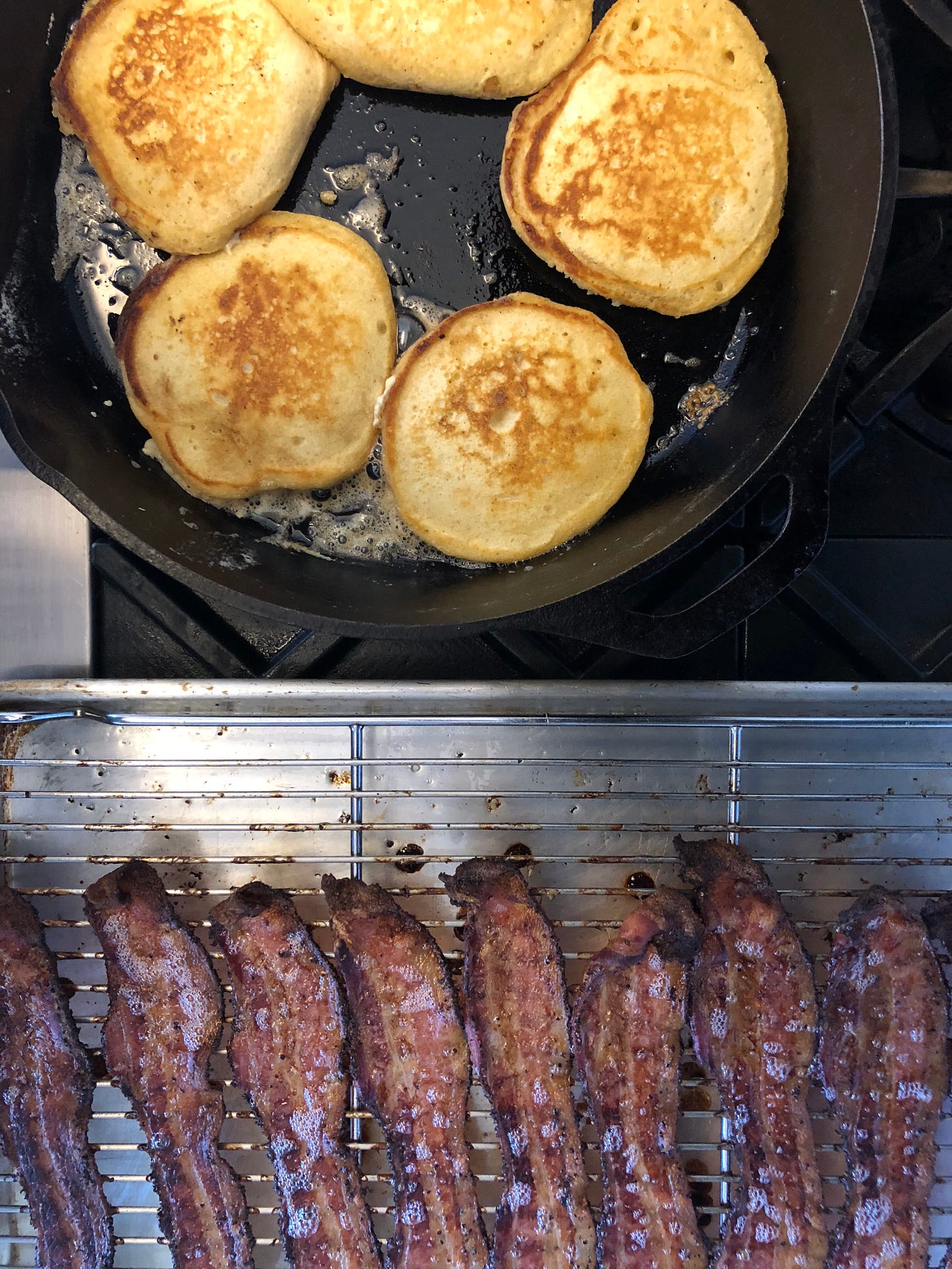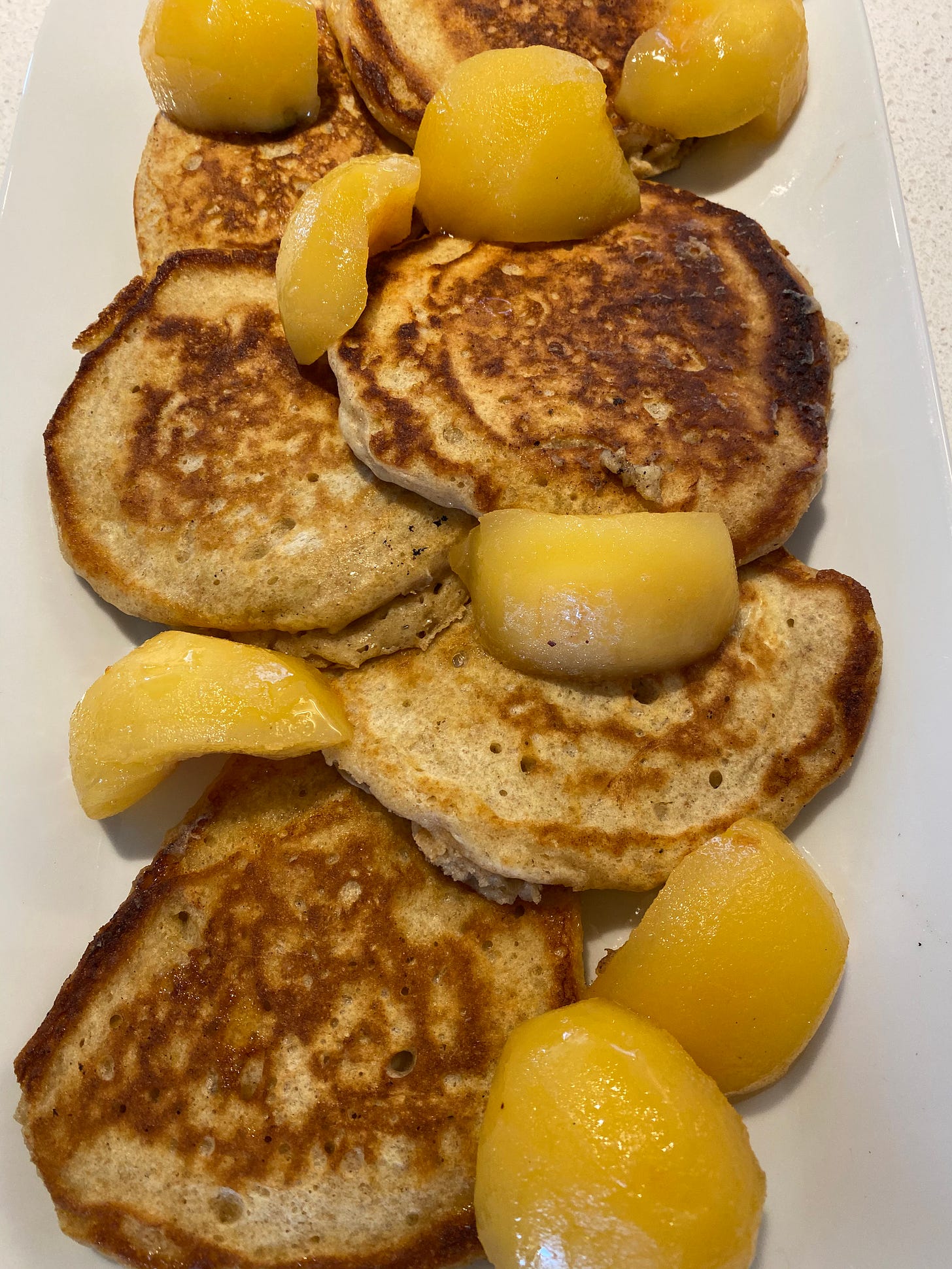Pancake Party: A Musical, In Three Acts
The Pancakes Song, Recipes for Buttermilk, Multigrain, and Sourdough Pancakes, Plus the Great Pancake Mystery
We’re back to breakfast here in Issue #9 of Kitchen Sense, pancakes specifically, however you like ‘em. Thank you for signing up and/or subscribing to my newsletter about home cooking and food in general. If you like what you read, cook, and eat, please consider sharing this one, all of them with family and friends.
Weekend mornings it is not unusual for me to be woken up by the folksy melody of Tom Knight’s Pancakes song playing on all the speakers in our apartment.
🎶
Here’s a little riddle.
For those who use a griddle.
What’s flat across the middle
And round around the edge?
Easier than pie,
Why don’t you discuss ‘em?
I can’t tell you why,
Everybody likes them. 🎵
‘Cuz they’re pancakes, pancakes.
Sunny, little, tan cakes
Stack them high until the sky
And I’ll be happy until I die.
Oh pancakes.
I love you so….
🎶
The song is my husband Nate’s way of telling me what he wants for breakfast. Sometimes he dances to it. The tune rattles around one’s brain all day. Sometimes longer. As I type, I started whistling it. HELP ME! The song is totally unnecessary because I know that pancakes are what Nate wants any and every day for breakfast. Fifteen years into our relationship, he is still surprised that pancakes can be made from scratch, and that he can have them whenever he wants.
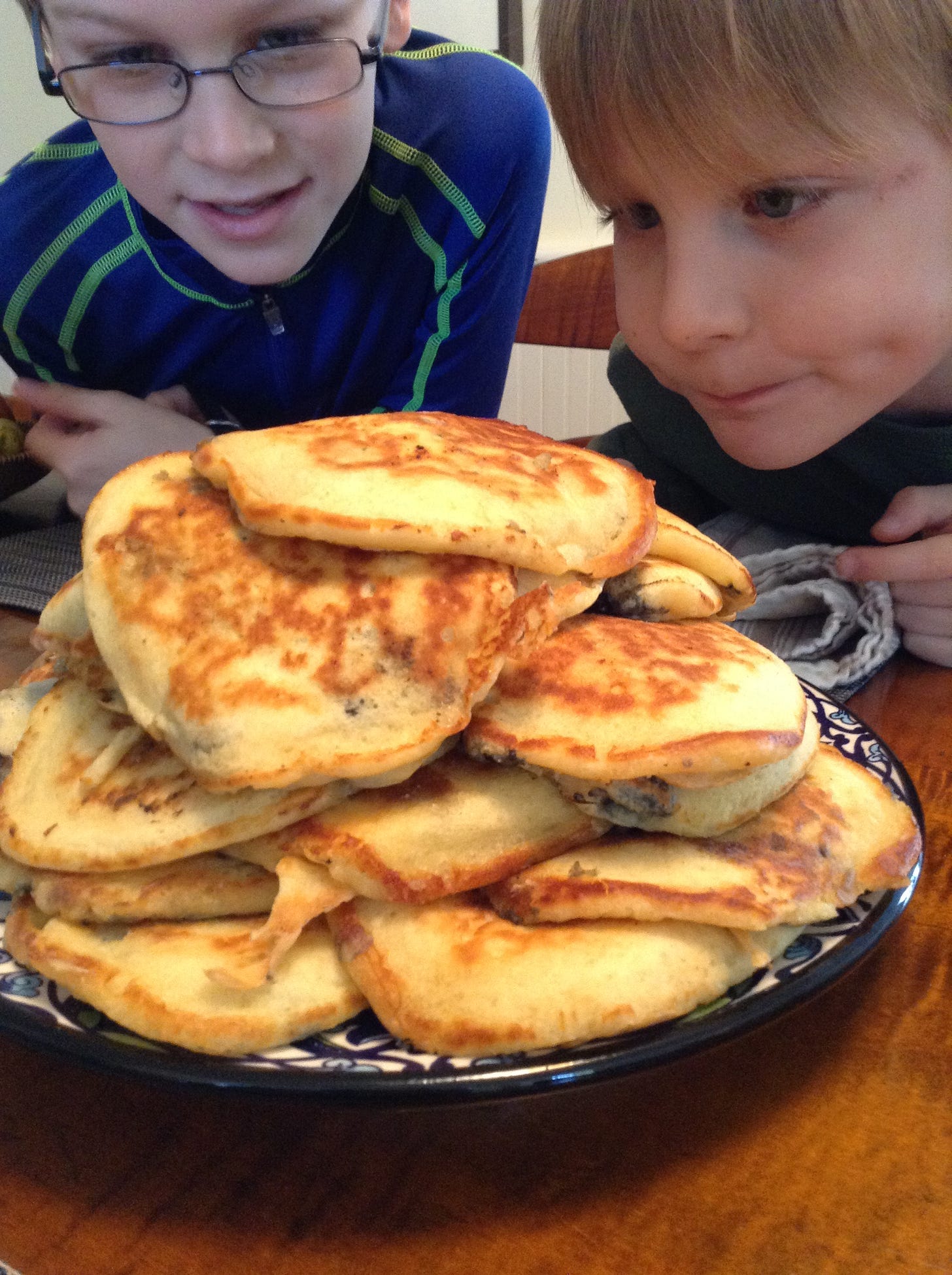
I’ve been using the same buttermilk pancake recipe I developed in 1996 for my first cookbook, Cook Something. (Nowadays, I cut the recipe in half so there’s just enough for breakfast for two.) They are light and fluffy, with the cozy flavor of flour and baking soda that reminds me of southern biscuits. Over the years, no surprise, I’ve found that when I use freshly milled flour, cultured butter, and whole-fat buttermilk they are particularly delicious. But they are also very good with ingredients from the corner store. I always have buttermilk on hand because it lasts forever (weeks, maybe months longer than its expiration date) and because I know Nate always wants pancakes. I also have some powdered buttermilk that I keep in the cupboard for emergencies. But if you don’t have either, you can employ my universal dairy substitution trick of thinning plain or vanilla yogurt or even sour cream down with milk to a pourable consistency. I treat most dairy as interchangeable. I’ve made these pancakes with heavy cream (reducing the melted butter to compensate for the butterfat in the ream). You can also make them with sour milk or milk soured with a teaspoon of lemon juice.
This recipe has appeared on the pages of GQ magazine and on the James Beard Foundation website. I know it by heart, of course, but here it is for you:
RECIPE: Mitchell’s Buttermilk Pancakes
Makes seven 3- to 4-inch pancakes, serving two hungry people, one a pancake lover. This recipe can be easily doubled or tripled to serve a crowd.
1 cup all-purpose flour
2 teaspoons sugar
1/2 teaspoon kosher salt
1/2 teaspoon baking powder
1/4 teaspoon baking soda
3/4 cup buttermilk, full-fat if you can find it, or else low-fat or a combination of plain or vanilla yogurt or sour cream thinned down with milk to a pourable consistency (see comments above)
1/4 cup milk, of any kind
1 large egg
1/2 teaspoon pure vanilla extract
4 tablespoons unsalted butter, divided
Preheat the oven to 250°F. (if you plan to wait to serve breakfast until all of the pancakes are ready, that is).
In a medium bowl, combine the flour, sugar, salt, baking powder, and baking soda, and stir with a whisk or fork to thoroughly combine. In a 2-cup liquid measuring cup, combine the buttermilk, milk, egg and vanilla, and beat until the egg is blended.
In a large cast-iron pan, melt 2 tablespoons of the butter over medium heat. Pour the buttermilk mixture and the melted butter into the flour mixture, and using a fork, mix just until blended. Be careful not to overmix. A small lump or two in the batter is fine.
Return the pan to the heat and add another tablespoon of butter. Heat until sizzling. Using a large tablespoon or small ladle, make three or four pancakes in different quadrants of the pan. Lower the heat a little. Cook until bubbles appear on the surface of the pancakes and the edges appear brown, about 4 to 6 minutes. I find it helps to rotate the pan over the flame to ensure even cooking. When bubbled all over, flip the pancakes and cook the second side, another 2 to 3 minutes. Remove to a sheet pan or heat-proof serving dish and set in the preheated oven to keep warm while you finish cooking the remaining pancakes.
Take the pan off the heat for a minute or two to cool. Add the remaining tablespoon of butter, swirl it around the pan to melt, and return the pan to the heat. Repeat the frying described above with the remaining batter. If you have more, keep going.
To make blueberry, raspberry, or chocolate pancakes, add a few berries or chips to the individual pancakes once they are in the pan. (This works better than stirring them into the batter.) Press them down with your fingertips to settle into the batter before flipping. If you do not eat cow’s milk, I’ve made these substituting 1 cup of either almond or oat milk for the buttermilk and regular milk. Add a teaspoon of lemon juice or ½ teaspoon white vinegar to replace tartness of the buttermilk. They come out a little stodgier but still delicious.
A Pancake Mystery
Although I’ve used this recipe uncountable times, the actual pancakes that come out vary from one batch to another. I’m not sure why. If I’ve done one of my dairy substitutions, that would explain it. But even using all the ingredients as written, they are not always the same. I suspect it could be due to variation in my locally ground flour or my poor measuring skills before coffee, I dunno. Sometimes they are fluffier, sometimes, flatter. Regardless, they are always delicious.
Note, this sort of variation from the same recipe is not unusual. When you write recipes and people share what they’ve cooked with you, it can be quite a surprise to see their results. Ingredients vary, every cook has a different understanding, a different touch. No amount of recipe testing can avoid it. A good recipe should produce a good result, regardless. Rather than worry about the variation, I just let it go and celebrate the diversity.
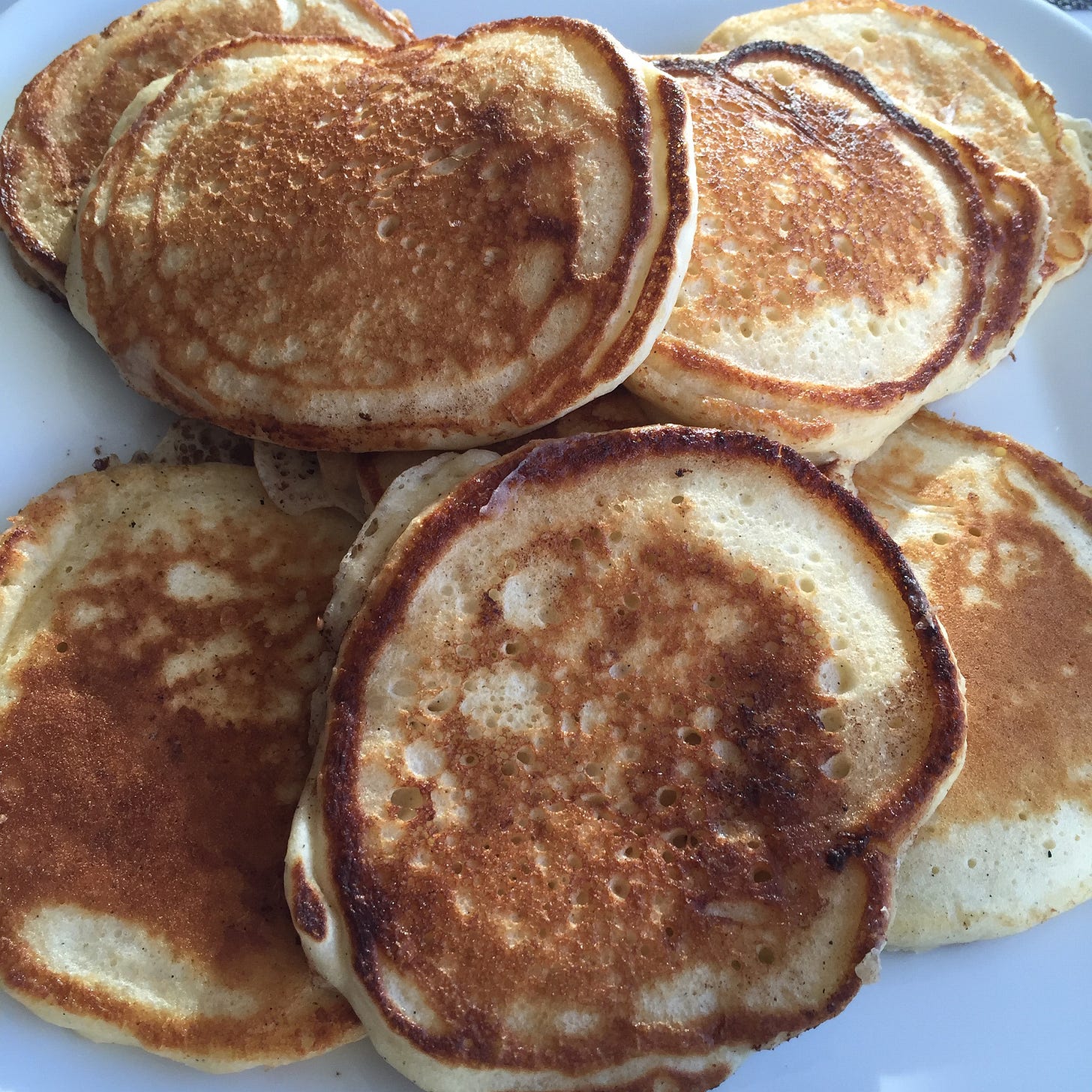
Like any pan-fried thing, pancakes are best eaten right out of the pan. But if everyone wants to sit down to breakfast at the same time, the first ones should be kept warm in a 250*F. oven until all of them are cooked, as I’ve suggested in the recipe above. If you have leftovers, store them wrapped in the fridge and reheat them in the microwave for 20 to 30 seconds (depending on how powerful your microwave is), no more. Leftover pancakes are quite different from freshly made ones, but they satisfy a craving, as Nate will attest.
Fluffy buttermilk pancakes are hands down Nate’s favorite. He prefers them plain, without berries. He always takes one right away and tastes it without any maple syrup on it to get the pure taste and texture. Tbh, they are not my favorite. I need more flavor, more texture, more fiber in my mornings. In fact, I prefer savory breakfasts. Sometimes I add blueberries to my pancakes—not to his—to make them more interesting to me, more healthful. Ever since some blueberry marketing group paid someone to do research that anointed blueberries a superfood, it feels virtuous to eat them. Blueberry pancakes hold the promise of immortality.
More Flavor, More Nutrition
Over the years I’ve experimented with different combinations of whole grains in pancakes to try to boost their nutritional content and to add some variety to my own breakfast, having committed myself to a pancake lover for life. Luckily, I had developed a multigrain pancake recipe for Kitchen Sense, which came out in 2006. A little heavier and denser than buttermilk pancakes, they are nevertheless delicious. I make the batter slightly looser, the pancakes thinner, to compensate for their heft. Of course, you can use any combination of grains you like, keeping similar proportions. You need some gluten from wheat to hold everything in place and help the pancakes rise, but the other grains are there for flavor and nutrition and you can substitute whatever you please. Buckwheat is a natural suggestions, but there are so many different flours available these days it’s fun to experiment.
RECIPE: Multigrain Pancakes from Kitchen Sense
Makes about ten 3-inch pancakes. This recipe can be doubled or tripled to feed a crowd.
1/4 cup rye flour
1/4 cup whole-wheat flour
1/2 cup all-purpose flour
2 tablespoons cornmeal
1 tablespoon ground flax seed
2 tablespoons sugar
1 1/2 teaspoons baking powder
Scant 1/4 teaspoon baking soda
3/4 teaspoon kosher salt
2 large eggs
1 3/4 cups buttermilk or 1 1/2 cups sour milk, or see dairy substitution comments above
1 teaspoon pure vanilla extract
About 4 tablespoons unsalted butter
In a medium bowl, combine the rye, whole-wheat and all-purpose flours along with the cornmeal, flax, sugar, baking powder, and baking soda. Use a mix to really blend everything together well. In a small bowl, beat together the eggs, buttermilk and vanilla extract until well combined. Melt 2 tablespoons of the butter in a large frying pan, and then pour the buttermilk mixture along with the melted butter into the dry ingredients and stir just to combine.
Fry and store the pancakes as described above in Mitchell’s Buttermilk Pancake recipe.
And then, Of Course, Sourdough Pancakes
As you know, if you’ve been following me on Instagram or reading previous issues of this newsletter, I jumped on the sourdough bandwagon about year ago and have become obsessed with finding uses for sourdough discard. It turns out pancakes is one of the best. The sourness of the sourdough starter alludes to buttermilk. Because I use whole wheat in my starter, the discard contributes both nutrition and flavor. Over the last few months I would say I have perfected my sourdough pancake recipe to mine and Nate’s tastes. The final piece of the puzzle was replacing some of the wheat flour with brown rice flour, which lifted them up a little, making them lighter and less stodgy. Note that my sourdough starter is fed with 100% whole wheat, with the occasional spoonful of whole rye thrown in. The water ratio is about 107%. This gives these pancakes a pronounced wheaty flavor that I like. If your starter is fed white flour, I would substitute half of the flour called for in the recipe with whole wheat. Also, since writing my previous cookbooks I’ve become convinced of the ease and accuracy of metric weights for cooking, so I’ve provided them here. In fact, come to think of it, these pancakes come out consistent time and again, so perhaps it is the variability in measuring that has caused my buttermilk pancake recipe to produce noticeably different results.
RECIPE: Sourdough Pancakes
Makes seven 4-inch pancakes
108 g all-purpose flour (3/4 cup)
42 g brown rice flour (1/4 cup)
1 teaspoon baking powder
1/2 teaspoon baking soda
1 tablespoon sugar
1/2 teaspoon kosher salt
140 g 1/2 cup whole-wheat sourdough starter discard (1/2 cup)
167 g whole milk (2/3 cup)
1 egg
1/2 teaspoon vanilla paste or extract
1 tablespoon unsalted butter, melted and cooled, plus additional butter for frying
In a medium bowl, combine the flours, baking powder, baking soda and sugar. Mix with whisk to combine well. In a separate small bowl, combine the salt, sourdough starter, milk, egg, and vanilla and beat with a whisk until blended. Make sure the sourdough starter has all dissolved. Pour the wet ingredients into the dry ingredients along with the melted butter. Mix just until combine. Do not over mix.
Cook the pancakes as described above in Mitchell’s Buttermilk Pancakes recipe.
And On The Side
Any one of the caramel fruit sauces from the last issue of Kitchen Sense is delicious with pancakes, along with pure maple syrup, of course.
